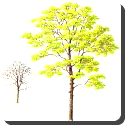 Honey Locust — The Honey locust (Gleditsia triacanthos) is a deciduous tree native to eastern North America. It is mostly found in the moist soil of river valleys ranging from southeastern South Dakota to New Orleans and central Texas, and as far east as central Pennsylvania.
Honey Locust — The Honey locust (Gleditsia triacanthos) is a deciduous tree native to eastern North America. It is mostly found in the moist soil of river valleys ranging from southeastern South Dakota to New Orleans and central Texas, and as far east as central Pennsylvania.
Honey locusts can reach a height of 20–30 m (66–100 ft), with fast growth, and are relatively short-lived; about 120 years. They are also prone to losing large branches in windstorms. The leaves are pinnately compound on older trees but bipinnately compound on vigorous young trees. The leaflets are 1.5–2.5 cm (smaller on bipinnate leaves) and bright green. They turn yellow in the fall. The strongly scented cream-colored flowers appear in late spring, in clusters emerging from the base of the leaf axils.
The fruit of the Honey locust is a flat legume (pod) that matures between September and October. The pods are generally between 15–20 cm. The pulp on the insides of the pods is edible and sweet, unlike the Black locust, which is toxic. The seeds are dispersed by grazing herbivores such as cattle and horses, which eat the pod pulp and excrete the seeds in droppings; the animal’s digestive system assists in breaking down the hard seed coat, making germination easier.
Honey locusts commonly have thorns 10–20 cm long growing out of the branches; these may be single, or branched into several points, and commonly form dense clusters. The thorns are fairly soft and green when young, harden and turn red as they age, then fade to ash grey and turn brittle when mature. These thorns are thought to have evolved to protect the trees from grazing Pleistocene megafauna which may also have been involved in seed dispersal. Thornless forms (f. inermis) are occasionally found growing wild.
Despite its name, Honey locust is not a significant honey plant. The name derives from the sweet taste of the legume pulp, which was used for food by Native American people, and can also be fermented to make beer.
A Native American legend is that the Thunder Spirit recognized his son by his ability to sit comfortably on locust branches, despite the thorns.
Its cultivars are popular ornamental plants, especially in the northern plains of North America where few other trees can survive and prosper. It tolerates urban conditions, compacted soil, road salt, alkaline soil, heat and drought. The popularity is in part due to the fact that it transplants so easily. The fast growth rate and tolerance of poor site conditions make it valued in areas where shade is wanted quickly, such as new parks or housing developments, and in disturbed and reclaimed environments, such as mine tailings. It is resistant to Gypsy moths but is defoliated by another pest, the mimosa webworm. Spider mites, cankers, and galls are a problem with some trees.
 Kids Portal For Parents India Kids Network
Kids Portal For Parents India Kids Network






